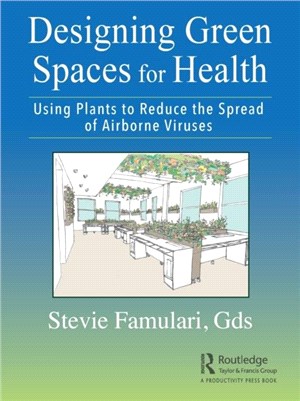目前查詢
歷史查詢

Designing Green Spaces for Health :Using Plants to Reduce the Spread of Airborne Viruses /
- 館藏(1)
- 書目資訊
- 心得(0)
- 機讀格式
- 標籤
書名 : Designing Green Spaces for Health :Using Plants to Reduce the Spread of Airborne Viruses /
紀錄類型 : 書目-語言資料,印刷品: 單行本
正題名[資料類型標示]/作者 : Designing Green Spaces for Health :Stevie Famulari, Gds.
其他題名 : Using Plants to Reduce the Spread of Airborne Viruses /
其他題名 : Using Plants to Reduce the Spread of Airborne Viruses
作者 : Famulari, Stevie.
出版者 : New York :Productivity Press,c2022.
面頁冊數 : xix, 159 p. :col. ill. ;28 cm.
標題 : Environmental health.
ISBN : 9780367683139
發表心得
LEADER 03551cam a2200229 a 4500
001 1124214
008 220726s2022 nyua e b 001 0 eng d
020 $a9780367683139$q(pbk.) :$cGBP45.99
020 $a036768313X$q(pbk.) :$cGBP45.99
035 $aNO000223069
037 $b公共圖書館臺南分區資源中心
040 $aYDX$beng$eaacr2$cYDX$dUKMGB$dOCLCF$dBDX$dOCLCO$dYDX$dTWTNM
050 4$aSB419.25$b.F36 2022
082 04$a747.98$223
090 $a臺南市立圖書館
100 1 $aFamulari, Stevie.
245 10$aDesigning Green Spaces for Health :$bUsing Plants to Reduce the Spread of Airborne Viruses /$cStevie Famulari, Gds.
246 30$aUsing Plants to Reduce the Spread of Airborne Viruses
260 $aNew York :$bProductivity Press,$cc2022.
300 $axix, 159 p. :$bcol. ill. ;$c28 cm.
504 $aIncludes bibliographical references and index.
520 $aThis book focuses on using plants in spatial design to reduce the infectiousness of viruses in different working and living spaces. It presents strategies of interior and exterior green designs with plants that are likely effective for flu virus tolerance and reduction of infectiousness. The designs are appealing for human interaction and healing, as well as focusing on the reduction and removal of virus infectiousness. The Famulari Theory requires examining plants that are likely effective for virus accumulation based on their leaves with stomata, trichomes, and dense leaf growth, and transpiration rate accumulation of airborne viruses. In addition, this research requires reviewing the quantity and specific types of plants (as well as electronic sources, such as humidifiers and water features) needed to produce effective humidity for plants to decrease the infectiousness or transmission of viruses; the effective distance of people to plants; and light, water, soil, and temperature needs. The book addresses the various greening practices that can be applied to sites to reduce the infectiousness of the airborne flu virus - especially in areas such as train stations, restaurants, rooftops, courtyards, office buildings and work spaces/conference rooms, and the home office - and the ways that businesses owners and residents can integrate these practices to improve the air contaminants with a green solution. Designing green spaces that accumulate, reduce, and remove the infectiousness of viruses involves exploring multiple approaches from different directions to achieve the most effective and ideal design. The six basic approaches include 1. Temperature minimum of 70° Fahrenheit 2. Plants with multiple stomata on the leaf surfaces 3. Plants with multiple clumps of dense leaves with a high transpiration rate 4. Plants with rough leaf surfaces or with trichomes (plant hairs) on the leaf 5. Relative humidity (RH) minimum of 43% or higher 6. Air circulation to direct air with the airborne flu virus to the planted areas Stevie Famulari brings unique insights and inspires the development of green understanding and design solution plans with both short-term and long-term approaches. Illustrations of greening applied to locations help you understand your own design solutions to create them in your site. This book breaks down the misconceptions of the complexity of sustainability and green practices and provides illustrations and site-appropriate green solutions that you can incorporate into your lifestyle for a healthier site. Greening is a lifestyle change, and this guide lets you know how easy it is to transition to the green side to improve your health.
650 0$aEnvironmental health.
650 0$aPlants as sanitary agents.
650 0$aBuildings$xEnvironmental engineering.
650 0$aPlants in architecture.
650 0$aArchitecture$xEnvironmental aspects.
653 $a知識性
653 $a樂活環保
